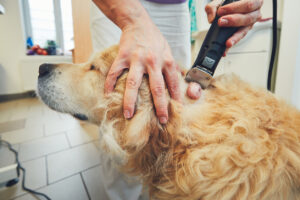The winter holiday season is a popular time for people to get new pets, whether as a gift from someone or as a gift to yourself. Bringing a new pet into your home can be an exciting experience, but it is also a commitment. It can also be challenging – from knowing what kind of food to feed them and how to keep them healthy to providing adequate exercise and stimulation, there’s much to consider when caring for a pet. We have 8 helpful tips to care for a new pet.
1. Acquire Necessary Supplies
If you haven’t brought your new pet home yet, it is essential to equip yourself with the necessary supplies that they need. Depending on your pet, this may include items like:
- a bed
- food bowl and water bowl
- kennel or enclosure (if needed)
- litter box
- toys
Get your supplies in advance so that when your pet arrives, they immediately feel comfortable in their new environment.
If you received a pet as a Christmas gift, you may not have had time to get your supplies in advance. If this is the case, improvise as best you can until you can get the proper supplies. For example, kittens will do fine with a small cardboard box or box lid with litter for a litter box until you can buy an appropriate littler box. Newspapers will do for potty training a puppy until you can get some puppy pads.
2. Create a Safe Environment
Ensuring your pet has a safe, comfortable, and enjoyable environment is essential for their well-being. Provide them with the right type of housing and enough space to roam.
For example, if you get a dog, you should create a secure area that they can play in – this means fencing off your property from nearby roads or paths and sources of potential danger.
We highly recommend you keep cats indoors. Roaming cats can be hit by cars, get diseases from other roaming cats, and be attacked by dogs or even coyotes if you live on the outskirts of Houston. The Houston Chronicle reported in September 2022 that coyotes have become commonplace in Houston’s outskirts, where expanding development that used to be open range habitat is pushing wildlife like coyotes into backyards, searching for food and shelter. If you want your cats to enjoy the outdoors, catios or cat fences, such as those offered by the Purrfect Fence, are safer solutions.
Keeping your pet safe can save you from heartache, and expensive vet bills should your pet have a bad incident while roaming the streets.
3. Keep Your Pet Out of Harm’s Way of Toxins
Part of having a safe environment is ensuring your new pet is not exposed to any poisonous substances or toxic food. Just as a parent would child-proof their home to safeguard their children, pet parents need to pet-proof their homes. Pet-proofing starts with knowing which foods and substances around the home are toxic to pets. You can get a list of poisonous substances from this article from the FDA: POTENTIALLY DANGEROUS ITEMS FOR YOUR PET.
4. Introduce New Pets to Resident Pets Slowly
If you already have pets in your home, introduce your new pet to your resident pets slowly. Pets can react differently to humans than they react to other pets. That soft purring kitten in your arms could become a menacing hisser and scratcher if thrown in suddenly with other pets or end up hiding and never coming out. Some pets hit it off immediately, while others can take time to warm up to each other.
Play it safe and keep new pets from resident pets until they get used to each other’s smells and presence, like sniffing each other from under a door or through a kennel or cage. Then introduce them slowly and ensure each pet can retreat safely in case either one becomes afraid or antagonistic. Be patient! Pushing introductions too quickly with any pet can result in an unharmonious household that no one wants.
5. Give Them an Appropriate Diet
Providing your pet with a balanced and nutritious diet is essential to proper pet care.
Before you bring home your new pet, consult the breeder or rescue center regarding the type of food they have previously been eating so you can match their diet as closely as possible. As your pet’s diet requirements may vary depending on their age and breed, monitor them closely and adjust their eating habits accordingly. You can also get advice from us as needed.
Important Note: If you want to change your pet’s food, for example, from dry to canned wet food, change the diet gradually. Sudden changes in a pet’s diet can make them sick. Below is a chart that gives a guideline for transitioning them to a new food. While transitioning, if your pet suffers from severe diarrhea or diarrhea that lasts more than three days, contact us without delay.

6. Get Your Pet Microchipped and a Collar ID
Losing a pet is a heart-wrenching experience no one wants to suffer through. Even when you take every precaution you can think of, accidents can happen. A door is not shut correctly, the wind blows it open, and your kitten runs out. You think your dog is safely in their yard, but a serviceman leaves the gate open. Here are some sobering statistics regarding lost pets:
- Only 48% of dogs and 19% of cats are wearing identification even though recovery of a lost pet requires that the animal is wearing identification.
- Only 58.1% of microchipped pets were registered with the respective agencies, preventing recoveries.
To guard against losing your new companion, get your pet microchipped and get them a collar with an ID tag. If your pet already has a microchip and ID collar, ensure the microchip registration is up to date and in your name, and update the ID with your information. If your pet has not been spayed or neutered, you can get them microchipped at the same appointment for their surgery.
7. Get Your Pet Spayed or Neutered
There are many benefits to getting your pet spayed or neutered. The most obvious one is that it helps to lower the overpopulation of pets, resulting in thousands of animals being euthanized yearly.
Medical Benefits of Spaying or Neutering
There are also medical benefits to getting your pet spayed or neutered. Spaying helps prevent malignant or cancerous uterine infections and breast tumors in about 50 percent of dogs and 90 percent of cats. Neutering your male companion prevents testicular cancer and some prostate problems. Your pet gets the best protection if you have it done before your pet’s first heat.
Not all exotic pets need to be spayed or neutered. But for some, spaying or neutering can significantly add to their life expectancy. For example, studies have shown that intact female rabbits have as high of a 65% chance of developing uterine cancer by the age of 4 years.
8. Give Them Plenty of Exercise
Pets who don’t get enough exercise get bored and boredom often leads to mischief. Additionally, lack of exercise sets the stage for weight gain which leads to other health problems. So, you want to start out on the right foot and exercise your pet.
- A healthy dog should be taken out for a walk for at least 20-30 minutes a day – more if they can tolerate longer walks.
- Cats naturally want to jump, climb, and scratch. If your cat is indoor only, provide them with one or more cat trees to climb and scratching posts. Wand toys or laser lights are great toys to stimulate cats and get them moving. We recommend you play with your cat 30-60 minutes a day. This time can be broken up into segments such as 15-20 minutes three times a day.
- Exotic pets need mental and physical enrichment every day too, especially if they are kept in some type of enclosure. Small pets kept constantly in cages or enclosures may lose muscle tone or become obese if they don’t get enough activity outside of their cages or enclosures. Also, many exotic pets enjoy human interaction and look forward to playtime.
Schedule Your Pets First Wellness Check with Braescroft Animal Clinic
One of the easiest and least expensive ways to keep your pet healthy is to bring them in for their wellness checks. Dr. Lisa Lowenstein may pick up on a concern early that might otherwise go undiagnosed or untreated. Regular checkups allow us to establish a baseline in your pet’s health and make us aware of any changes that may indicate future problems. Often health problems that go undetected can become more serious issues when left untreated, so checkups are important even when your pet appears healthy.
Exotic Pets
Exotic pets include a wide variety of animals, such as:
| Birds | Rabbits | Turtles | Sugar Gliders |
| Hamsters | Ferrets | Tortoises | Hedgehogs |
| Guinea pigs | Snakes | Frogs | Pot Bellied Pigs |
| Rats & Mice | Lizards | Toads | Spiders |
We give special mention here of exotic pets because we find sometimes, they are misunderstood by some pet owners. We have seen some kept in tiny cages without enough room to move around and some receive little or no attention or care. It is easy for parents to give in to children’s requests for a pet. However, especially when children are young and lose interest in the pet, the pet may be abandoned outside to fend for themselves. The problem of abandonment and euthanasia is particularly high for rabbits purchased in pet stores, as they tend to be impulse buys, especially on the days before Easter.
So, the above tips apply to exotic pets too. They need safe environments, slow introductions to household pets, species-appropriate diets, and plenty of attention and exercise.
Final Words
There is a lot to know about bringing home a new pet – no matter how well you prepare, challenges can arise with a new pet you didn’t expect. But we are here to help you keep your pet happy and healthy. Please contact us if you have any questions about your new pet or exotic pet and how to keep it healthy.
Your Friends at
Braescroft Animal Clinic





